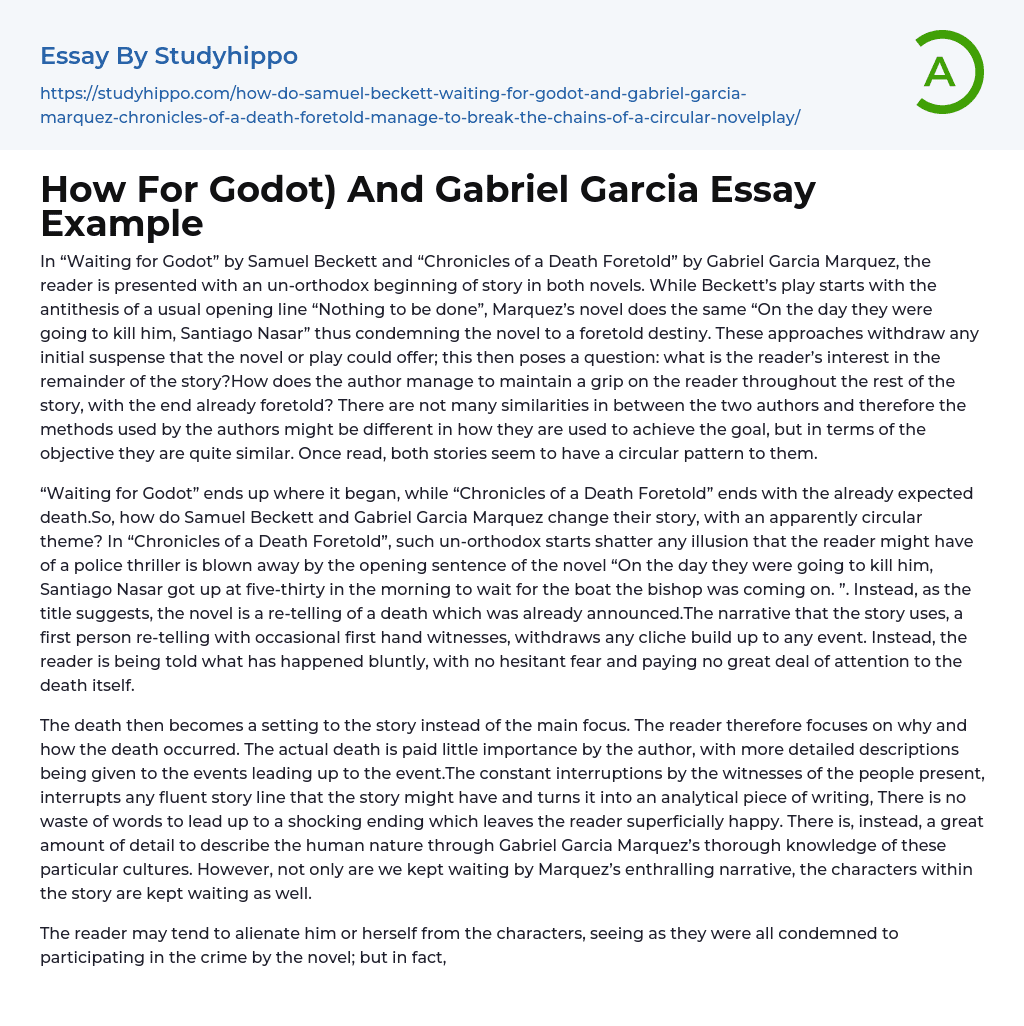Both Samuel Beckett's "Waiting for Godot" and Gabriel Garcia Marquez's "Chronicles of a Death Foretold" begin in an unorthodox way, presenting the reader with an unexpected opening line that withdraws any initial suspense. In Beckett's play, the antithesis of a usual opening line is used: "Nothing to be done". Similarly, Marquez's novel begins with "On the day they were going to kill him, Santiago Nasar", already condemning the novel to a foretold destiny. Despite this, both authors manage to maintain the reader's interest throughout the remainder of the story. Although there are not many similarities between the two authors and their methods vary, they both use circular patterns in their narratives. The objective is similar: to keep the reader engaged despite already knowing the outcome.
Both "Waiting for Godot" and "Chronicles of a Death Foretold" employ circular themes, but w
...ith different approaches. In the latter, Gabriel Garcia Marquez subverts traditional expectations from the outset: the opening sentence, "On the
Rather than being the main focus, the death serves as a setting for the story. The author places more emphasis on the events leading up to the death and why it occurred. Witness interruptions throughout the story prevent a fluid storyline and turn it into an analytical piece of writing. Gabriel Garcia Marquez's thorough knowledge of specific cultures allows for in-depth descriptions of human nature. There is no buildup to a shocking ending, yet the reader is superficially satisfied. Furthermore, both the reader and characters within the story are kept waiting due to Marquez's captivating narrative.
Although the reader may feel disconnected from the characters who have all been implicated in the crime in the novel, they are actually
very relatable. Like the reader, all of the minor characters are anticipating a reason for the murder that is about to occur. They realize that it is inevitable, but they seem to be searching for a rationale for it. Therefore, what initially appeared to be detachment can now be interpreted as the reader being included in the narrative. In "Waiting for Godot," the reader is once again immersed in the waiting process.
With an unusual theme of waiting, "Waiting for Godot" is an absurdist play that features Vladimir and Estragon - two wandering characters who find themselves trapped in the middle of nowhere, eagerly waiting for someone who may not exist. The story lacks any significant plot development or forward movement, with the author intentionally leaving the reader without any expectations. The play ends much like it began, as Estragon remarks, "[Giving up again] Nothing to be done" (pg.).
Samuel Beckett's play, provides a scene where both characters express a sense of stillness and hopefulness, leaving the story at a standstill as "Estragon: Yes, let’s go. They do not move" (pg. 88). However, language is used as a source of entertainment for these characters, shifting the focus of the story from their wait to their means of survival. Through this use of language, Beckett artfully imbues the play with a deeper meaning that goes beyond that of conventional plays.
Beckett's unconventional approach to playwriting directs the audience's focus towards the characters and their situation, rather than building suspense towards a predictable outcome. This engages the reader in a process of waiting, putting them in the same shoes as the characters. Initially, the reader may share Vladimir and
Estragon's hope that Godot will arrive. However, as the story progresses, it becomes apparent that he will never come, leaving the characters condemned to an eternal wait for someone who may not even exist. This burden is lifted from the reader, but not from the characters.
Samuel Beckett's experiment in "Waiting for Godot" contemplates human nature and uses his knowledge of language to turn an apparently dull and endless story into a sublime example of human relationship. Meanwhile, Marquez's "Chronicles of a Death Foretold" is a reflection of his thoughts and beliefs, leaving readers with an understanding of the situation and showcasing an example of human nature thanks to his undeniable writing talent. Both works use unique methods to attract and generate feeling and curiosity in the reader, ultimately leading to a deeper level of understanding.
- Nightclub essays
- Book Summary essays
- Metaphor essays
- Reader essays
- Rhyme essays
- Literary devices essays
- Villain essays
- Books essays
- Genre essays
- Literary Criticism essays
- Writer essays
- Protagonist essays
- Simile essays
- Poem essays
- Book Report essays
- Book Review essays
- Greek Mythology essays
- Plot essays
- Tragic Hero essays
- Coming of Age essays
- Play essays
- Rhetoric essays
- Rhetorical Question essays
- Translation essays
- Understanding essays
- Reason essays
- Character essays
- Letter essays
- American Literature essays
- Literature Review essays
- Utopia essays
- Poetry Analysis essays
- Dante's Inferno essays
- Between The World and Me essays
- Incidents in The Life of a Slave Girl essays
- Flowers for Algernon essays
- Myth essays
- Everyday Use essays
- Boo Radley essays
- Genesis essays
- Richard iii essays
- Alice in Wonderland essays
- On the road essays
- Ozymandias essays
- The Nightingale essays
- Holden Caulfield essays
- Animal Farm essays
- 1984 essays
- A Hanging essays
- Shooting An Elephant essays




